
The Douglas A-3 Skywarrior is a jet-powered strategic bomber that was developed and produced by the Douglas Aircraft Company. It was designed by Douglas on behalf of the United States Navy, which sought a carrier-capable strategic bomber. During July 1949, Douglas was awarded the contract to produce its design, having bested eight other aircraft companies' submissions. Unlike rival designs, which had aimed for a 100,000 lb (45,000 kg) maximum take-off weight, the Skywarrior was developed for a 68,000 lb (31,000 kg) take-off weight, facilitating its use from the navy's existing Midway-class aircraft carriers. Large portions of the aircraft were produced by the Westinghouse Electric Corporation, including its early Westinghouse J40 turbojet engines, which failed to meet promises and were replaced by the rival Pratt & Whitney J57 engine by mid-1953. On 28 October 1952, the prototype XA3D-1 performed the type's maiden flight.

The North American A-5 Vigilante is an American carrier-based supersonic bomber designed and built by North American Aviation (NAA) for the United States Navy. Before the 1962 unification of Navy and Air Force designations, it was designated A3J.

The North American AJ Savage is an American carrier-based medium bomber built for the United States Navy by North American Aviation. The aircraft was designed shortly after World War II to carry atomic bombs and this meant that the bomber was the heaviest aircraft thus far designed to operate from an aircraft carrier. It was powered by two piston engines and a turbojet buried in the rear fuselage. The AJ-1 first became operational in 1950 and several were based in South Korea during 1953 as a deterrent against North Korea. Of the 140 built, plus three prototypes, 30 were reconnaissance aircraft. Inflight-refueling equipment was deployed on the Savage in the mid-1950s. The bomber was replaced by the Douglas A3D Skywarrior beginning in 1957. The type was used after its military service for some additional experiments including microgravity test flights and to test a new jet engine in the 1960s and 70s.

A carrier air wing is an operational naval aviation organization composed of several aircraft squadrons and detachments of various types of fixed-wing and rotary-wing aircraft. Organized, equipped and trained to conduct modern US Navy carrier air operations while embarked aboard aircraft carriers, the various squadrons in an air wing have different but complementary missions, and provide most of the striking power and electronic warfare capabilities of a carrier battle group (CVBG). While the CVBG term is still used by other nations, the CVBG in US parlance is now known as a carrier strike group (CSG).

Naval Air Station Sanford was a naval air station of the United States Navy in Sanford, Florida, approximately 20 miles north of Orlando, Florida. Opening less than a year after the start of World War II, NAS Sanford's initial function was as an advanced training base for land-based patrol bombers, followed by carrier-based fighter aircraft. The air station briefly closed in 1946 and was placed in caretaker status until being reactivated in 1950. It eventually served as a Master Jet Base for carrier-based heavy attack and reconnaissance aircraft until 1969. After its closure, it reopened as civilian general aviation airport under various names with a non-Navy civilian airport identifier until finally transitioning to a scheduled air carrier airport under its current name of Orlando-Sanford International Airport.

Electromagnetic Attack Squadron 131 (VAQ-131), also known as the "Lancers," is a United States Navy tactical jet aircraft squadron specializing in kinetic and non-kinetic Suppression of Enemy Air Defenses (SEAD). They are based at Naval Air Station Whidbey Island, flying the EA-18G Growler. Their radio callsign is "Skybolt."

Electromagnetic Attack Squadron 132 (VAQ-132), the "Scorpions", is a United States Navy aircraft squadron based at Naval Air Station Whidbey Island, flying the EA-18G Growler. The squadron's radio callsign is "Scorp".

Admiral Richard Michael Dunleavy is a retired US naval officer. He retired as a two-star rear admiral in 1992 after being demoted from the rank of three-star vice admiral as a result of the Tailhook scandal.

VAH-8, was a Heavy Attack Squadron of the U.S. Navy, based at NAS Whidbey Island, Washington. It was established on 1 May 1957 and disestablished on 17 January 1968. The squadron primarily flew the Douglas A-3 Skywarrior aircraft.
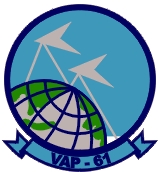
VAP-61 was a Heavy Photographic Squadron of the U.S. Navy. Originally established as VP-61 on 20 January 1951, it was redesignated VJ-61 on 5 March 1952. It was redesignated as VAP-61 in April 1956, redesignated as VCP-61 on 1 July 1959 and redesignated as VAP-61 on 1 July 1961. The squadron was disestablished on 1 July 1971.

VAP-62 was a Heavy Photographic Squadron of the U.S. Navy. Originally established as Photographic Squadron Sixty-Two (VJ-62) on 10 April 1952, it was redesignated as Heavy Photographic Squadron (VAP-62) on 2 July 1956. The squadron was disestablished on 15 October 1969.

RVAH-1 was a Reconnaissance Attack (Heavy) Squadron of the U.S. Navy. Originally established as Heavy Attack Squadron One (VAH-1) on 1 November 1955, it was redesignated as Reconnaissance Attack (Heavy) Squadron One (RVAH-1) on 1 September 1964. The squadron was disestablished on 29 January 1979.
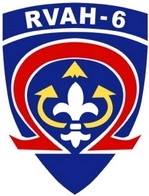
RVAH-6 was a Reconnaissance Attack (Heavy) Squadron of the U.S. Navy. Originally established as Composite Squadron Six (VC-6) on 6 January 1950, it was redesignated as Heavy Attack Squadron Six (VAH-6) on 1 July 1956 and was redesignated as Reconnaissance Attack (Heavy) Squadron Six (RVAH-6) on 23 September 1965. The squadron was disestablished on 20 October 1978.

RVAH-9 was a Reconnaissance Attack (Heavy) Squadron of the U.S. Navy. Originally established as Composite Squadron Nine (VC-9) on 15 January 1953, it was redesignated as Heavy Attack Squadron Nine (VAH-9) on 1 November 1955 and was redesignated as Reconnaissance Attack (Heavy) Squadron Nine (RVAH-9) on 3 June 1964. The squadron was disestablished on 30 September 1977.

RVAH-13 was a Reconnaissance Attack (Heavy) Squadron of the U.S. Navy. Originally established as Heavy Attack Squadron Thirteen (VAH-13) on 3 January 1961 it was redesignated as Reconnaissance Attack (Heavy) Squadron Thirteen (RVAH-13) on 1 November 1964. The squadron was disestablished on 30 June 1976.
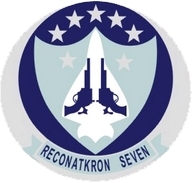
RVAH-7 was a reconnaissance attack (heavy) squadron of the U.S. Navy. Originally established as Composite Squadron Seven (VC-7) on 10 August 1950, it was redesignated as Heavy Attack Squadron Seven (VAH-7) on 1 November 1955 and was redesignated again as Reconnaissance Attack (Heavy) Squadron Seven (RVAH-7) on 1 December 1964. The squadron was disestablished on 28 September 1979.
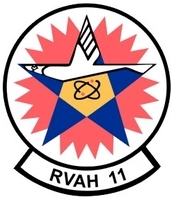
RVAH-11 was a Reconnaissance Attack (Heavy) Squadron of the U.S. Navy. Originally established as Composite Squadron Eight (VC-8) on 3 December 1951, it was redesignated Heavy Attack Squadron Eleven (VAH-11) on 1 November 1955 and was redesignated as Reconnaissance Attack (Heavy) Squadron Eleven (RVAH-11) on 1 July 1966. The squadron was disestablished on 1 June 1975.

RVAH-3 was a Reconnaissance Attack (Heavy) Squadron of the U.S. Navy that served as the Fleet Replacement Squadron (FRS) for the RVAH community. Originally established as Heavy Attack Squadron Three (VAH-3) on 15 June 1956, it was redesignated as Reconnaissance Attack (Heavy) Squadron Three (RVAH-3) on 1 July 1964. The squadron was disestablished on 17 August 1979.
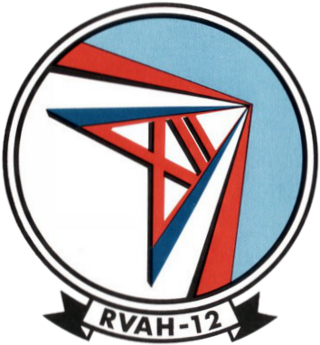
RVAH-12 was a Reconnaissance Attack (Heavy) Squadron of the U.S. Navy. The squadron was established on 1 July 1965 and disestablished on 2 July 1979.

RVAH-14 was a Reconnaissance Attack (Heavy) Squadron of the U.S. Navy. The squadron was established on 14 February 1968 and disestablished on 1 May 1974.





















